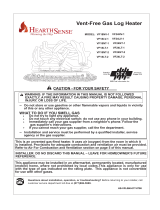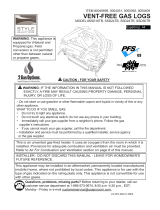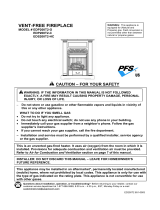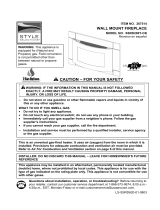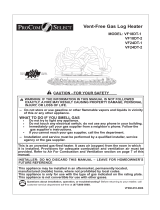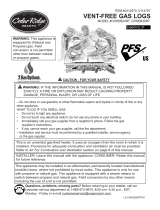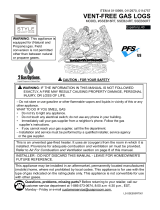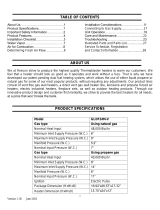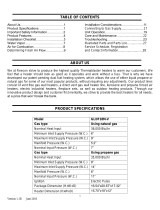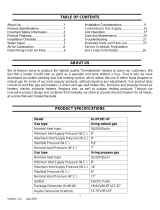Page is loading ...

AMBILOG VENT-FREE GAS LOG HEATER
PFS
®
US
WARNING: If the information in this manual is not
followed exactly, a re or explosion may result causing
property damage, personal injury or loss of life.
— Do not store or use gasoline or other ammable va-
pors and liquids in the vicinity of this or any other
appliance.
— WHAT TO DO IF YOU SMELL GAS
• Do not try to light any appliance.
• Do not touch any electrical switch; do not use any
phone in your building.
•
Immediately call your gas supplier from a neighbor’s
phone. Follow the gas supplier’s instructions.
• If you cannot reach your gas supplier, call the re
department.
—
Installation and service must be performed by a quali-
ed installer, service agency or the gas supplier.
INSTALLER: Leave this manual with the appliance.
CONSUMER: Retain this manual for future reference.
Questions, problems, missing parts? Before returning to your retailer, call
our customer service department at 1-866-573-0674, 8:00 am - 4:30 pm CST,
Monday through Friday or email customerservice@usaprocom.com
MODELS
VF18NA-2
VF18LA-2
VF24NA-2
VF24LA-2

www.usaprocom.com
200067-01A2
TABLE OF CONTENTS
Specications ............................................ 3
Safety ........................................................ 3
Product Features ....................................... 5
Local Codes............................................... 5
Unpacking.................................................. 5
Qualied Installing Agency ........................ 6
Water Vapor: A By-Product Of
Unvented Room Heaters ..................... 6
Air For Combustion and Ventilation ........... 6
Installation ................................................. 9
Operation ................................................. 19
Inspecting Burners................................... 22
Care And Maintenance ............................ 23
Troubleshooting ....................................... 24
Replacement Parts .................................. 27
Technical Services ................................... 27
Accessories ............................................. 27
Parts ........................................................ 28
Warranty .................................................. 32
This is an unvented gas-red heater. It uses air (oxygen)
from the room in which it is installed. Provisions for ad-
equate combustion and ventilation air must be provided.
Refer to Air for Combustion and Ventilation section on
page 6 of this manual.
WARNING: Improper installation, adjustment, al-
teration, service or maintenance can cause injury or
property damage. Refer to this manual for correct in-
stallation and operational procedures. For assistance
or additional information consult a qualied installer,
service agency or the gas supplier.
This appliance may be installed in an aftermarket,* per-
manently located, manufactured (mobile) home, where
not prohibited by local codes.
This appliance is only for use with propane or natural
gas. This appliance is equipped with a simple means to
switch between propane and natural gas. Field conver-
sion by any other means including the use of a kit is
not permitted.
* Aftermarket: Completion of sale, not for purpose of resale, from the manufacturer.
SAVE THIS BOOK

www.usaprocom.com
3200067-01A
SPECIFICATIONS
SAFETY
IMPORTANT: Read this owner’s
manual carefully and completely
before trying to assemble, op-
erate, or service this heater.
Improper use of this heater can
cause serious injury or death
from burns, fire, explosion,
electrical shock and carbon
monoxide poisoning. Failure
to follow these instructions will
void the warranty.
Only a qualied installer, service
agent, or local gas supplier may
install and service this product.
WARNING: Keep the appli-
ance area clear and free from
combustible materials, gasoline,
and other ammable vapors and
liquids.
This appliance is only for use
with the type of gas indicated on
the rating plate. This appliance
is not convertible for use with
other gases.
WARNING: Models VF18NA-2
and VF24NA-2 are equipped for
natural gas. Models VF18LA-2
and VF24LA-2 are equipped for
propane/LP gas. Field conver-
sion is not permitted.
DANGER: Carbon monoxide
poisoning may lead to death!
Carbon Monoxide Poisoning: Early signs
of carbon monoxide poisoning resemble the
u, with headaches, dizziness or nausea. If
you have these signs, the heater may not
be working properly. Get fresh air at once!
Have heater serviced. Some people are
more affected by carbon monoxide than oth-
ers. These include pregnant women, people
with heart or lung disease or anemia, those
under the inuence of alcohol and those at
high altitudes.
Natural And Propane/LP Gas: Natural and
Propane/LP gas are odorless. An odor-making
agent is added to the gas. The odor helps you
detect a gas leak. However, the odor added to
the gas can fade. Gas may be present even
though no odor exists.
WARNING: Do not use any
accessory not approved for use
with this log set.
WARNING: Do not allow fans
to blow directly into the heater.
Avoid any drafts that alter burner
ame pattern including ceiling
fans. Altered burner patterns
can cause sooting.
WARNING: Any change to
this heater or its controls can
be dangerous.
MODEL
VF18NA-2 VF18LA-2 VF24NA-2 VF24LA-2
Ignition Electronic Piezo Electronic Piezo Electronic Piezo Electronic Piezo
Gas Type Natural Propane/LP Natural Propane/LP
Input Rating 30,000 BTU/Hr 28,000 BTU/Hr 37,500 BTU/Hr 34,000 BTU/Hr
Manifold Pressure 3.5" W.C. 10" W.C. 3.5" W.C. 10" W.C.
Inlet Gas Pressure*
(inches of water)
Max. 10.5" W.C. Max. 14" W.C. Max. 10.5" W.C. Max. 14" W.C.
Min. 5" W.C. Min. 11" W.C. Min. 5" W.C. Min. 11" W.C.
* For purposes of input adjustment.

www.usaprocom.com
200067-01A4
WARNING: Do not place
clothing or other flammable
material on or near the appli-
ance. Never place any objects
in the heater.
WARNING: Due to high tem-
peratures, the appliance should
be located out of trafc and away
from furniture and draperies.
WARNING: Heater becomes
very hot when running. Keep
children and adults away from
hot surfaces to avoid burns or
clothing ignition. Heater will re-
main hot for a time after shutoff.
Allow surfaces to cool before
touching.
WARNING: Carefully super-
vise young children when they
are in the room with the heater.
WARNING: Make sure a re-
place screen is in place before
running heater.
1. Do not place Propane/LP supply tank(s)
inside any structure. Propane/LP supply
tank(s) must be placed outdoors.
2. This heater should not be installed in a
bedroom or bathroom unless installed as
a vented appliance.
3. This heater needs fresh air ventilation to
run properly. This heater has an Oxygen
Depletion Sensing (ODS) safety shutoff
system. The ODS shuts down the heater
if not enough fresh air is available. See
Air for Combustion and Ventilation, pages
6 through 8. If heater keeps shutting off,
see Troubleshooting, page 24.
4. Do not add extra logs or ornaments such
as pine cones, vermiculite, or rock wool.
Using these added items can cause soot-
ing. Do not add lava rock around base.
Rock and debris could fall into the control
area of heater. After servicing, always
replace screen before operating heater.
SAFETY
5. If replace has glass doors, never operate
this heater with glass doors closed. If you
operate heater with doors closed, heat will
build-up inside replace and cause glass
to burst. If replace opening has vents
at the bottom, you must open the vents
before operating log set. Always operate
heater with glass doors fully open.
6. This log heater is designed to be smoke-
less. If logs ever appear to be smoking,
turn off heater and call a qualied service
technician. NOTE: During initial operating,
slight smoking could occur due to log cur-
ing and heater burning off manufacturing
residues.
7. To prevent the creation of soot, follow the
instructions under Care and Maintenance
page 23.
8. Do not run heater:
• Where ammable liquids or vapors are
used or stored.
• Under dusty conditions.
9. Before using furniture polish, wax, carpet
cleaner, or similar products, turn heater
off. If heated, the vapors from these prod-
ucts may create a white powder residue
within burner box or on adjacent walls or
furniture.
10. Do not use heater if any part has been
under water. Immediately call a qualied
service technician to inspect the room
heater and to replace any part of the
control system and any gas control which
has been under water.
11. Turn off and unplug heater and let cool
before servicing. Only a qualied service
person should service and repair heater.
12. Operating heater above elevations of
4,500 feet could cause pilot outage.
13. Do not use this heater if any log is broken.
Do not operate heater if a log is chipped
(dime-size or larger).
14. To prevent performance problems, do
not use propane/LP fuel tank of less than
100 lbs. capacity.
15. Solid fuels should not be burned in
replace in which a vent-free log set is
installed. Do not use this heater to cook
food or burn paper or other objects.

www.usaprocom.com
5200067-01A
PRODUCT FEATURES
This log set has been tested and approved to ANSI Z21.11.2 standard for Unvented Heaters
and can be operated with the ue damper closed. State and local codes in some areas prohibit
the use of vent-free heaters.
Install and use heater with care. Follow all
local codes. In the absence of local codes,
use the latest edition of The National Fuel
Gas Code, ANSI Z223.1/NFPA 54*.
*Available from:
American National Standards Institute, Inc.
1430 Broadway
New York, NY 10018
National Fire Protection Association, Inc.
1 Batterymarch Park
Quincy, MA 02269-9101
LOCAL CODES
State of Massachusetts: The installation
must be made by a licensed plumber or
gas tter in the Commonwealth of Mas-
sachusetts.
Sellers of unvented propane or natural
gas-red supplemental room heaters shall
provide to each purchaser a copy of 527
CMR 30 upon sale of the unit.
In the State of Massachusetts the gas
cock must be a T-handle type. The State
of Massachusetts requires that a exible
appliance connector cannot exceed three
feet in length.
UNPACKING
CAUTION: Do not remove the
metal data plates from the burner
pan. The data plates contain
important product information.
1. Remove logs and burner base assembly
from carton. NOTE: Do not pick up burner
base assembly by burners as this could
damage heater. Always handle base as-
sembly by grate.
2. Remove all protective packaging applied
to logs and base for shipment.
3. Check all items for any shipping damage.
If damaged, promptly inform dealer where
you purchased the heater.
SAFETY PILOT
This heater has a pilot with an Oxygen Deple-
tion Sensing (ODS) safety shutoff system. The
ODS/pilot shuts off the heater if there is not
enough fresh air.
PIEZO IGNITION SYSTEM
This heater is equipped with an electronic
piezo control system. This system requires
AAA batteries (provided).
Figure 1 - Product Identication
Burner

www.usaprocom.com
200067-01A6
QUALIFIED INSTALLING AGENCY
Only a qualied agency should install and
replace gas piping, gas utilization equipment
or accessories, and repair and equipment ser-
vicing. The term “qualied agency” means any
individual, rm, corporation, or company that
either in person or through a representative
is engaged in and is responsible for:
a) Installing, testing, or replacing gas piping
or
b) Connecting, installing, testing, repairing,
or servicing equipment; that is experienced
in such work; that is familiar with all precau-
tions required; and that has complied with
all the requirement of the authority having
jurisdiction.
In areas that prohibit the use of vent-free
heaters, the log set has been tested and
approved to the ANSI Z21.60 standard for
Vented Decorative Logs. When used as a
vented log set refer to additional instructions
on page 11.
WATER VAPOR: A BY-PRODUCT OF
UNVENTED ROOM HEATERS
Water vapor is a by-product of gas combus-
tion. An unvented room heater produces ap-
proximately one (1) ounce (30 mL) of water
for every 1,000 BTUs (0.3 KWs) of gas input
per hour. Unvented room heaters are recom-
mended as supplemental heat (a room) rather
than a primary heat source (an entire house).
In most supplemental heat applications, the
water vapor does not create a problem. In
most applications, the water vapor enhances
the low humidity atmosphere experienced
during cold weather.
The following steps will help ensure that water
vapor does not become a problem.
1. Be sure the heater is sized properly for the
application, including ample combustion
air and circulation air.
2. If high humidity is experienced, a dehu-
midier may be used to help lower the
water vapor content of the air.
3. Do not use an unvented room heater as
the primary heat source.
AIR FOR COMBUSTION AND VENTILATION
WARNING: This heater shall
not be installed in a conned
space or unusually tight construc-
tion unless provisions are provid-
ed for adequate combustion and
ventilation air. Read the following
instructions to insure proper fresh
air for this and other fuel-burning
appliances in your home.
Today’s homes are built more energy efcient
than ever. New materials, increased insulation
and new construction methods help reduce
heat loss in homes. Home owners weather
strip and caulk around windows and doors
to keep the cold air out and the warm air in.
During heating months, home owners want
their homes as airtight as possible.
While it is good to make your home energy
efcient, your home needs to breathe. Fresh
air must enter your home. All fuel-burning ap-
pliances need fresh air for proper combustion
and ventilation.
Exhaust fans, replaces, clothes dryers and
fuel burning appliances draw air from the house
to operate. You must provide adequate fresh
air for these appliances. This will insure proper
venting of vented fuel-burning appliances.
PROVIDING ADEQUATE VENTILATION
The following are excerpts from National Fuel
Gas Code, ANSI Z223.1/NFPA 54, Air for
Combustion and Ventilation.
All spaces in homes fall into one of the three
following ventilation classications:
1. Unusually Tight Construction
2. Unconned Space
3. Conned Space
The information on pages 6 through 8 will help
you classify your space and provide adequate
ventilation.

www.usaprocom.com
7200067-01A
DETERMINING FRESH-AIR FLOW FOR HEATER LOCATION
Determining if You Have a Conned or Unconned Space
3. Add the Btu/Hr of all fuel burning appli-
ances in the space.
Vent-free heater _________ Btu/Hr
Gas water heater* _________ Btu/Hr
Gas furnace _________ Btu/Hr
Vented gas heater _________ Btu/Hr
Gas replace logs _________ Btu/Hr
Other gas appliances*+ _______ Btu/Hr
Total = ________ Btu/Hr
* Do not include direct-vent gas appli-
ances. Direct-vent draws combustion
air from the outdoors and vents to the
outdoors.
Example:
Gas water heater __________ Btu/Hr
Vent-free heater + _________ Btu/Hr
Total = _________ Btu/Hr
4. Compare the maximum Btu/Hr the space
can support with the actual amount of Btu/
Hr used.
_______Btu/Hr (maximum can support)
_______Btu/Hr (actual amount used)
Example: 51,200 Btu/Hr (maximum the
space can support)
56,000 Btu/Hr (actual amount
of Btu/Hr used)
AIR FOR COMBUSTION AND VENTILATION
30,000
26,000
56,000
Use this work sheet to determine if you have
a conned or unconned space.
Space: Includes the room in which you will
install heater plus any adjoining rooms with
doorless passageways or ventilation grills
between the rooms.
1. Determine the volume of the space (length
x width x height).
Length x Width x Height =__________
cu. ft. (volume of space)
Example: Space size 20 ft. (6.1 m)
(length) x 16 ft. (4.88 m) (width) x
8 ft. (2.44 m) (ceiling height) = 2560 cu.
ft. (72.49 m
3
) (volume of space)
If additional ventilation to adjoining room
is supplied with grills or openings, add the
volume of these rooms to the total volume
of the space.
2. Multiply the space volume by 20 to deter-
mine the maximum Btu/Hr the space can
support.
________(volume of space) x 20 =
(Maximum Btu/Hr the space can support)
Example: 2560 cu. ft. (72.49 m
3
) (volume
of space) x 20 = 51,200 (maximum Btu/
Hr the space can support)
Unusually Tight Construction
The air that leaks around doors and windows
may provide enough fresh air for combustion
and ventilation. However, in buildings of un-
usually tight construction, you must provide
additional fresh air.
Unusually tight construction is dened as
construction where:
a. walls and ceilings exposed to the outside
atmosphere have a continuous water
vapor retarder with a rating of one perm
(6 x 10
-11
kg per pa-sec-m
2
) or less with
openings gasketed or sealed and
b. weather stripping has been added on
openable windows and doors and
c. caulking or sealants are applied to areas
such as joints around window and door
frames, between sole plates and oors,
between wall-ceiling joints, between wall
panels, at penetrations for plumbing, elec-
trical and gas lines and at other openings.
If your home meets all of these three criteria,
you must provide additional fresh air. See
Ventilation Air From Outdoors, page 8.
If your home does not meet all of the three
criteria above, proceed to Determining Fresh-
Air Flow For Heater Location, page 7.
Conned and Unconned Space
The National Fuel Gas Code, ANSI Z223.1/
NFPA 54 denes a conned space as a space
whose volume is less than 50 cubic feet per
1,000 Btu/hr (4.8 m
3
per kw) of the aggregate
input rating of all appliances installed in that
space and an unconned space as a space
whose volume is not less than 50 cubic feet per
1,000 Btu/hr (4.8 m
3
per kw) of the aggregate
input rating of all appliances installed in that
space. Rooms communicating directly with the
space in which the appliances are installed*,
through openings not furnished with doors, are
considered a part of the unconned space.
* Adjoining rooms are communicating only if
there are doorless passageways or ventilation
grills between them.

www.usaprocom.com
200067-01A8
VENTILATION AIR
AIR FOR COMBUSTION AND VENTILATION
Outlet
Air
Ventilated
Attic
Outlet
Air
Inlet
Air
Inlet Air
Ventilated
Crawl Space
To
Crawl
Space
To Attic
Figure 2 - Ventilation Air from Inside
Building
Figure 3 - Ventilation Air from Outdoors
Or
Remove
Door into
Adjoining
Room,
Option
3
Ventilation Grills
Into Adjoining Room,
Option 2
Ventilation
Grills Into
Adjoining
Room,
Option 1
12"
12"
Ventilation Air From Inside Building
This fresh air would come from an adjoining
unconned space. When ventilating to an
adjoining unconned space, you must provide
two permanent openings: one within 12" of the
ceiling and one within 12" of the oor on the
wall connecting the two spaces (see options
1 and 2, Figure 2). You can also remove door
into adjoining room (see option 3, Figure 2).
Follow the National Fuel Gas Code, ANSI
Z223.1/NFPA 54, Air for Combustion and
Ventilation for required size of ventilation
grills or ducts.
Ventilation Air From Outdoors
Provide extra fresh air by using ventilation
grills or ducts. You must provide two perma-
nent openings: one within 12" of the ceiling
and one within 12" of the oor. Connect these
items directly to the outdoors or spaces open
to the outdoors. These spaces include attics
and crawl spaces. Follow the National Fuel
Gas Code, ANSI Z223.1/NFPA 54, Air for
Combustion and Ventilation for required size
of ventilation grills or ducts.
IMPORTANT: Do not provide openings
for inlet or outlet air into attic if attic has a
thermostat-controlled power vent. Heated air
entering the attic will activate the power vent.
Rework worksheet, adding the space of the
adjoining unconned space. The combined
spaces must have enough fresh air to supply
all appliances in both spaces.
The space in the above example is a conned
space because the actual Btu/Hr used is more
than the maximum Btu/Hr the space can sup-
port. You must provide additional fresh air.
Your options are as follows:
A. Rework worksheet, adding the space
of an adjoining room. If the extra space
provides an unconned space, remove
door to adjoining room or add ventilation
grills between rooms. See Ventilation Air
From Inside Building.
B. Vent room directly to the outdoors. See
Ventilation Air From Outdoors.
C. Install a lower Btu/Hr heater, if lower Btu/
Hr size makes room unconned. If the ac-
tual Btu/Hr used is less than the maximum
Btu/Hr the space can support, the space
is an unconned space. You will need no
additional fresh air ventilation.
WARNING: If the area in which
the heater may be operated does
not meet the required volume for
indoor combustion air, combus-
tion and ventilation air shall be
provided by one of the methods
described in the National Fuel
Gas Code, ANSI Z223.1/NFPA
54, the International Fuel Gas
Code, or applicable local codes.

www.usaprocom.com
9200067-01A
INSTALLATION
NOTICE: This heater is intended
for use as supplemental heat.
Use this heater along with your
primary heating system. Do not
install this heater as your pri-
mary heat source. If you have a
central heating system, you may
run system’s circulating blower
while using heater. This will help
circulate the heat throughout the
house. In the event of a power
outage, you can use this heater
as your primary heat source.
WARNING: A qualied ser-
vice person must install heater.
Follow all local codes.
WARNING: Before installing
in a solid fuel burning replace,
the chimney ue and rebox
must be cleaned of soot, creo-
sote, ashes and loose paint by
a qualified chimney cleaner.
Creosote will ignite if highly
heated. A dirty chimney ue may
create and distribute soot within
the house. Inspect chimney ue
and rebox for damage. If dam-
aged, repair ue before operat-
ing heater.
WARNING: Seal any fresh
air vents or ash clean-out doors
located on oor or wall of re-
place. If not, drafting may cause
pilot outage or sooting. Use a
heat-resistant sealant. Do not
seal chimney ue damper.
WARNING: Never install the
heater
• in a bedroom or bathroom
• in a recreational vehicle
• where curtains, furniture, cloth-
ing, or other ammable objects
are less than 36" from the front,
42" from top, or 16" from sides
of the heater.
• in high trafc areas
• in windy or drafty areas
CAUTION: This heater cre-
ates warm air currents. These
currents move heat to wall sur-
faces next to heater. Installing
heater next to vinyl or cloth wall
coverings or operating heater
where impurities (such as to-
bacco smoke, aromatic candles,
cleaning uids, oil or kerosene
lamps, etc.) in the air exist, may
discolor walls or cause odors.
NOTICE: State or local codes
may only allow operation of this
appliance in a vented congura-
tion. Check your state or local
codes.
WARNING: This appliance is
designed for installation in only
a solid-fuel burning masonry or
UL 127 factory-built replace or
in a listed ventless rebox enclo-
sure. Exception: DO NOT install
this appliance in a factory-built
replace that includes instruc-
tions stating it has not been
tested or should not be used
with unvented gas logs.

www.usaprocom.com
200067-01A10
Figure 4 - Minimum Clearance for
Combustible to Wall
INSTALLATION
IMPORTANT: Vent-free heaters add moisture
to the air. Although this is benecial, installing
heater in rooms without enough ventilation air
may cause mildew to form too much moisture.
See Air for Combustion and Ventilation, pages
6 through 8.
Before beginning assembly or operation of
the product, make sure all parts are pres-
ent. Compare parts with package contents
list. If any part is missing or damaged, do
not attempt to assemble, install or operate
the product. Contact customer service for
replacement parts.
Before installing heater, make sure you have
the items listed below:
• Hardware package (provided with heater)
• Electric drill with 3/16" drill bit
• Phillips screwdriver
CHECK GAS TYPE
Be sure your gas supply is right for your heat-
er. Otherwise, call dealer where you bought
the heater for proper type heater.
CLEARANCES TO
COMBUSTIBLES
WARNING: Maintain the mini-
mum clearances. If possible,
provide greater clearances from
oor, ceiling, and adjoining wall.
Measure from outermost point
of heater.
Minimum Fireplace Clearance To
Combustible Materials
Side Wall 16", Ceiling 42", Front 36"
LOG SIZING REQUIREMENTS
Minimum Firebox Size
18" Log Set: Height 20", Depth 13",
Front Width 26", Rear Width 20"
24" Log Set: Height 20
1
/
2
", Depth 14",
Front Width 30", Rear Width 22"
Minimum Clearances For Side
Combustible Material, Side Wall
and Ceiling
A. Clearance from the side of the replace
cabinet to any combustible material and
wall should follow diagram in Figure 4.
B. Clearance from the top of the replace
opening to the ceiling must not be less
than 42".
Minimum Noncombustible Material
Clearances
If Not Using Mantel
Note: If using a mantel, proceed to If Using
Mantel, page 11. If not using a mantel, follow
the information below.
You must have noncombustible material(s)
above the replace opening. Noncombustible
materials (such as slate, marble, tile, etc.)
must be at least 1/2" thick. With sheet metal,
you must have noncombustible material be-
hind it. Noncombustible material must extend
at least 12" up (for all models). See Figure 5
for minimum clearances.
*Minimum 16" from Side Wall
*
Figure 5 - Heat Resistant Material (Slate,
Marble, Tile, etc.) Above Fireplace
Noncombustible
Material Distance
Requirements for Safe Installation
(A) 12" or more: Noncombustible
material OK.
(A) Between 8" and 12":
Install replace hood accessory.
(A) Less than 8": Noncombustible
material must be extended to at least 8".
See Between 8" and 12", above. If you
cannot extend material, you must operate
heater with ue damper open.

www.usaprocom.com
11200067-01A
NOTICE: This heater may be
used as a vented product. If so,
you must always operate log set
with chimney ue damper open.
If running log set with damper
open, noncombustible material
above replace opening is not
needed. Go to Installing Damper
Clamp Accessory for Vented
Operation, page 12.
If Using Mantel
You must have noncombustible material(s)
above the replace opening. Noncombustible
materials (such as slate, marble, tile, etc.)
must be at least 1/2" thick. With sheet metal,
INSTALLATION
Figure 6 - Minimum Mantel Clearances
Without Using Hood
Figure 7 - Minimum Mantel Clearances
When Using Hood
Minimum
Noncombustible
Material
Minimum
Noncombustible
Material Height
Distances to
Underside of
Mantel
Top of
Fireplace
Opening
Underside of
Mantel Shelf
Mantel Shelf
8"
(A)
8" 14" 16" 20"
18" Log Set
12" 18" 20" 22" 24" 24" Log Set
All minimum
distances are
in inches
2
1
/
2
"
6"
8"
10"
Minimum
Noncombustible
Material
8"
Min.
12" 15" 18" 20"
2½"
6"
8"
10"
12"
Distances to
Underside of
Mantel
Hood
Top of
Fireplace
Opening
Underside
of Mantel
Shelf
Mantel Shelf
you must have noncombustible material be-
hind it. Noncombustible material must extend
at least 8" up. If noncombustible material is
less than 12", you must install the replace
hood accessory. Even if noncombustible
material is more than 12", you may need the
hood accessory to deect heat away from
your mantel shelf. See Figures 5, 6 and 7, for
minimum clearances.
MANTEL CLEARANCES
In addition to meeting noncombustible mate-
rial clearances, you must also meet required
clearances between replace opening and
mantel shelf. If you do not meet the clearances
listed below, you will need a hood.
Determining Minimum Mantel
Clearance
If you meet minimum clearance between
mantel shelf and top of replace opening, a
hood is not required (see Figure 6).
Determining Minimum Mantel
Clearance When Using a Hood
If minimum clearances in Figure 6 are not met,
you must have a hood. When using a hood
there are still certain minimum mantel clear-
ances required. Follow minimum clearances
shown in Figure 7, when using hood.
NOTICE: Surface temperatures
of adjacent walls and mantels
become hot during operation.
Walls and mantels above the
firebox may become hot to
the touch. If installed properly,
these temperatures meet the
requirement of the national
product standard. Follow all
minimum clearances shown in
this manual.
NOTICE: If your installation does
not meet the minimum clear-
ances shown, you must do one
of the following:
• operate the logs only with the
ue damper open
• raise the mantel to an accept-
able height
• move the mantel

www.usaprocom.com
200067-01A12
INSTALLATION
Figure 10 - Attaching Damper to Fireplace
Damper
Damper
Clamp
Hearth
5"
Min.
Combustible
Material
14"
Min.
Combustible
Material
Noncombustible Material
Figure 8 - Minimum Fireplace Clearances
If Installed at Floor Level
Figure 9 - Minimum Fireplace Clearances
Above Combustible Flooring
FLOOR CLEARANCES
INSTALLING DAMPER CLAMP ACCESSORY FOR VENTED
OPERATION
When used as a vented heater, appliance
must be installed only in a solid-fuel burning
replace with a working ue constructed of
noncombustible material. You may use this
heater as a vented product. There are three
reasons for operating your heater as a vented
model:
1. The replace does not meet the clearance
requirements for vent-free operation.
2. State or local codes do not permit vent-
free operation.
3. You prefer vented operation.
If reasons number 1 or 2 above apply, you
must permanently open chimney ue damper.
You must install the damper clamp accessory
(not provided). This will insure vented opera-
tion (see Figure 10). The damper clamp will
keep damper open. Installation instructions
are included with clamp accessory.
See chart below for the minimum permanent
ue opening you must provide. Attach damper
clamp so the minimum permanent opening will
be maintained at all times.
Chimney
Height
Minimum Permanent
Flue Opening
6' to 15' 39 sq inches
15' to 30' 29 sq inches
Area of Various Standard Round Flues
Diameter Area
5" 20 sq inches
6" 29 sq inches
7" 39 sq inches
8" 51 sq inches
A. If installing appliance on the oor level,
you must maintain the minimum distance
of 14" to combustibles (see Figure 8).
B. If combustible materials are less than 14"
to the replace, you must install appliance
at least 5" above the combustible ooring
(see Figure 9).

www.usaprocom.com
13200067-01A
INSTALLATION
Figure 11 - Attaching Heater Base to
Fireplace Floor
Masonry
Screw
Connecting
Wire
Connecting
Port
Battery Case
Ignitor
Receiver
WARNING: You must secure
this heater to replace oor. If
not, heater will move when you
adjust controls. Moving heater
may cause a gas leak.
WARNING: If installing in a
sunken replace, special care
is needed. You must raise the
replace oor to allow access to
heater control panel. This will in-
sure adequate air ow and guard
against sooting and controls
being damaged. Raise replace
oor with noncombustible mate-
rial. Make sure material is secure.
CAUTION: Do not pick up
heater base assembly by burn-
ers. This could damage heater.
Only handle base assembly by
grates.
IMPORTANT: Make sure the heater burners
are level. If heater is not level, heater will not
work properly.
Installation Items Needed
• hardware package (provided with heater)
• electric drill with 3/16" masonry drill bit
1. Position heater base assembly in re-
place. Center base assembly left to right
and front to back inside replace.
2. Mark screw locations through holes in
mounting brackets (see Figure 11). If
installing in a brick-bottom replace, mark
screw locations in mortar joint of bricks.
3. Remove heater base from replace.
4. Drill holes at marked locations using 3/16"
drill bit.
5. Apply pipe joint sealant lightly to tting
threads. Connect approved exible gas
hose to gas regulator of heater (see Figure
11). Note: Never apply pipe sealant to are
tting threads. Hold gas regulator with a
wrench when connecting exible gas hose.
6. Attach base assembly to replace oor
using two masonry screws provided in
hardware package (see Figure 11).
7. Connect to gas supply. See Connecting
To Gas Supply, page 14.
INSTALLING HEATER BASE ASSEMBLY
RECEIVER INSTALLATION
Insert one side of the connecting wire port into
the chassis (black and green line). Insert the
other side into the receiver port (see Figure 11).
BATTERY CASE INSTALLATION
Insert the bagttery case port into the ambiance
light connecting port (see Figure 11).
BATTERY INSTRUCTIONS
CAUTION: Do not mix old and
new batteries. Do not mix alka-
line, standard (carbon - zinc), or
rechargeable (nickel - cadmium)
batteries. Do not dispose of
batteries in re, batteries may
explode or leak.
• Batteries are included.
• Remove batteries when depleted.
• Be sure to observe proper polarity (+/-)
when installing or replacing the batteries.
Damage due to improper battery installa-
tion may void the warranty on the product.
• For long periods of non-operation, remove
batteries from all components for safety.
1. Unscrew ignitor cap and install a AAA bat-
tery with the + pointing out. Replace cap.
2. Install 4 AA batteries into receiver case,
and place case aside, away from chassis
(where batteries can easily be changed).
3. Install 2 D size batteries into battery case.
Place battery case to the side, away from
chassis (where batteries can easily be
changed).

www.usaprocom.com
200067-01A14
INSTALLATION
CONNECTING TO GAS SUPPLY
CAUTION: For natural gas,
check your gas line pressure
before connecting heater to gas
line. Gas line pressure must be
no greater than 10.5" WC. If gas
line pressure is higher, heater
regulator damage could occur.
CAUTION: Avoid damage to
regulator. Hold gas regulator
with wrench when connecting
into gas piping and/or ttings.
CAUTION: Use pipe joint
sealant that is resistant to gas
(Propane/LP or Natural Gas).
Before installing heater, make sure you have
the items listed below:
• external regulator for propane/LP unit only
(supplied by installer)
• piping (check local codes)
• sealant (resistant to natural gas and pro-
pane/LP gas)
• equipment shutoff valve*
• test gauge connection*
• sediment trap
• tee joint
• pipe wrench
• exible gas hose (check local codes)
* A CSA design-certied equipment shutoff
valve with 1/8" NPT tap is an acceptable al-
ternative to test gauge connection. Purchase
the optional CSA design certied equipment
shutoff valve from your dealer.
WARNING: A qualied ser-
vice technician must connect
heater to gas supply. Follow all
local codes.
WARNING: This appliance
requires a 1/2" NPT (National
Pipe Thread) inlet connection to
the pressure regulator.
WARNING: Do not over-
tighten gas connections.
WARNING: For natural gas,
Never connect heater to private
(non-utility) gas wells. This gas is
commonly known as wellhead gas.
CAUTION: For propane/
LP gas, never connect heater
directly to the gas supply. This
heater requires an external regu-
lator (not supplied). Install the
external regulator between the
heater and propane/LP supply.
Gas supplier provides external
regulator for natural gas. The
installer provides the external
regulator for propane/LP gas.
CAUTION: Use only new,
black iron or steel pipe. Inter-
nally tinned copper tubing may
be used in certain areas. Check
your local codes. Use pipe of
1/2" diameter or greater to allow
proper gas volume to heater. If
pipe is too small, undue loss of
pressure will occur.

www.usaprocom.com
15200067-01A
INSTALLATION
Figure 13 - Gas Connection
Figure 12 - Attaching Flexible Gas Hose
to Heater Gas Regulator
* Purchase the optional CSA design-certied equipment
shutoff valve from your dealer.
Typical Inlet Pipe Diameters
Use 1/2" black iron pipe or greater. Installa-
tion must include an equipment shutoff valve,
union, and plugged 1/8" NPT tap. Locate
NPT tap within reach for test gauge hook up.
NPT tap must be upstream from heater (see
Figure 13).
IMPORTANT: Install an equipment shutoff
valve in an accessible location. The equip-
ment shutoff valve is for turning on or shutting
off the gas to the appliance.
For propane/LP installations, apply pipe
joint sealant lightly to male threads. This will
prevent excess sealant from going into pipe.
Excess sealant in pipe could result in clogged
heater valves.
For propane/LP gas, the installer must supply
an external regulator. The external regulator
will reduce incoming gas pressure. You must
reduce incoming gas pressure to between 11"
WC and 14" WC. If you do not reduce incom-
ing gas pressure, heater regulator damage
could occur. Install external regulator with
the vent pointing down as shown in Figure
14. Pointing the vent down protects it from
freezing rain or sleet.
Figure 14 - External Regulator
with Vent Pointing Down
External
Regulator with
Vent Pointing
Down
Propane/LP
Supply Tank
Equipment
Shutoff Valve
Ground
Joint Union
3/8" NPT
Pipe Nipple
Flexible Gas Hose (if
allowed by local codes)
Fitting
Heater Gas
Regulator
Tee Joint
Reducer
Bushing to
1/8" NPT
1/8" NPT
Plug Tap
Test Gauge
Connection*
Sediment
Trap
Tee Joint
Pipe Nipple
Gap
3" Minimum
Install sediment trap in supply line as shown
in Figure 13. Place sediment trap where it is
within reach for cleaning. Place sediment trap
where trapped matter is not likely to freeze.
A sediment trap traps moisture and contami-
nants. This keeps them from going into heater
controls. If sediment trap is not installed or is
installed wrong, heater may not run properly.
WARNING: Test all gas piping
and connections for leaks after
installing or servicing. Correct
all leaks at once (see page 16).
Natural Gas
From Gas Meter
(5" W.C.** to
10.5" W.C.
Pressure)
Propane/LP
From External
Regulator
(11" W.C.**
to 14" W.C.
Pressure)

www.usaprocom.com
200067-01A16
INSTALLATION
Figure 15 - Equipment Shutoff Valve
CHECKING GAS CONNECTIONS
Open
Closed
Equipment
Shutoff Valve
3. Check all joints from gas meter to equip-
ment shutoff valve for natural gas or
propane/LP supply to equipment shutoff
valve for propane/LP (see Figure 16 or 17).
Apply a noncorrosive leak detection uid
to all joints. Bubbles forming show a leak.
4. Correct all leaks at once.
PRESSURE TESTING HEATER GAS
CONNECTIONS
1. Open equipment shutoff valve (see Fig-
ure 15).
2. Open main gas valve located on or near
gas meter for natural gas or open pro-
pane/LP supply tank valve.
3. Make sure control knob of heater is in the
OFF position.
4. Check all joints from equipment shutoff
valve to control valve (see Figure 16 or 17).
Apply a noncorrosive leak detection uid
to all joints. Bubbles forming show a leak.
5. Correct all leaks at once.
6. Light heater (see Lighting Instructions on
page 19). Check all other internal joints
for leaks.
7. Turn off heater (see To Turn Off Gas Ap-
pliance, page 20).
Control Valve
Location
Control Valve
Location
Equipment
Shutoff Valve
Equipment Shutoff Valve
External Regulator
Propane/LP
Supply Tank
Figure 16 - Checking Gas Joints for
Propane/LP Gas
Figure 17 - Checking Gas Joints for
Natural Gas
Gas Meter
WARNING: Test all gas piping
and connections, internal and
external to unit, for leaks after
installing or servicing. Correct
all leaks at once.
WARNING: Never use an open
ame to check for a leak. Apply a
noncorrosive leak detection uid
to all joints. If bubbles form, there
is a leak. Correct all leaks at once.
PRESSURE TESTING GAS SUPPLY
PIPING SYSTEM
Test Pressures In Excess Of 1/2 PSIG (3.5 kPa)
1. Disconnect heater with its appliance main
gas valve (control valve) and equipment
shutoff valve from gas supply piping sys-
tem. Pressures in excess of 1/2 PSIG will
damage heater regulator.
2. Cap off open end of gas pipe where equip-
ment shutoff valve was connected.
3. Pressurize supply piping system by either
opening propane/LP supply tank valve
for propane/LP gas or opening main gas
valve located on or near gas meter for
natural gas or using compressed air.
4. Check all joints of gas supply piping sys-
tem. Apply noncorrosive leak detection
uid to all joints. If bubbles form, there
may be a leak.
5. Correct all leaks at once.
6. Reconnect heater and equipment shutoff
valve to gas supply. Check reconnected
ttings for leaks.
Test Pressures Equal To or Less Than
1/2 PSIG (3.5 kPa)
1. Close equipment shutoff valve (see Fig-
ure 15).
2. Pressurize supply piping system by either
opening propane/LP supply tank valve
for propane/LP gas or opening main gas
valve located on or near gas meter for
natural gas or using compressed air.

www.usaprocom.com
17200067-01A
INSTALLATION
Figure 18 - Wiring Diagram
ELECTRICAL WIRING (MILLIVOLT)
CAUTION: Label all wires prior to disconnection when servicing
controls. Wiring errors can cause improper and dangerous opera-
tion. Verify proper operation after servicing.
Note: The millivolt valve is a self-powered combination gas control that does not require
110 VAC to operate.

www.usaprocom.com
200067-01A18
INSTALLATION
INSTALLING LOGS
WARNING: Failure to posi-
tion the parts in accordance
with these diagrams or failure
to use only parts specically
approved with this heater may
result in property damage or
personal injury.
CAUTION: After installation
and periodically thereafter,
check to ensure that no yellow
ame comes in contact with any
log. With the heater set to High,
check to see if yellow ames
contact any log. If so, reposi-
tion logs according to the log
installation instructions in this
manual. Yellow ames contact-
ing logs will create soot.
It is very important to install the logs exactly
as instructed. Do not modify logs. Use only
logs supplied with heater.
Each log is marked with a number. This
number will help you to identify the logs when
installing.
After installing logs, add decorative cinders
around the grate base, do not place any
decorative cinders on logs or burner.
1. Insert log #1 into slots in rear log bracket
on grate base and tighten nuts.
2. Insert log #2 on the pin to the left of the
burner.
3. Insert log #3 on the pin to the right of the
burner.
4. Insert the pin on the bottom of log #4 into
recessed hole in log #1, with the other end
placed on log #2.
5. Insert the pin on the bottom of log #5 into
recessed hole in log #1, with the other end
placed on log #3.
Figure 19 - Installing Logs #1, #2 and #3
Figure 20 - Installing Log #4, #5 and #6
Figure 21 - Installing Log #7 and #8
6. Insert the pin on the bottom of log #6 into
recessed hole in log #1, with the other end
placed on log #2.
7. Insert the recessed hole on the bottom
of log #7 onto pin on the log #6, with the
other end placed on log #3.
8. Place logs #8 on the oor in front of the
burner.

www.usaprocom.com
19200067-01A
OPERATION
WARNING: If you do not fol-
low these instructions exactly,
a re or explosion may result
causing property damage, per-
sonal injury or loss of life.
A. This appliance has a pilot which must
be lighted by hand. When lighting the
pilot, follow these instructions exactly.
B. BEFORE LIGHTING smell all around
the appliance area for gas. Be sure to
smell next to the oor because some
gas is heavier than air and will settle
on the oor.
WHAT TO DO IF YOU SMELL GAS
• Do not try to light any appliance.
• Do not touch any electric switch; do
not use any phone in your building.
• Immediately call your gas supplier
from a neighbor’s phone. Follow the
gas supplier’s instructions.
• If you cannot reach your gas supplier,
call the re department.
C. Use only your hand to push in or turn
the gas control knob. Never use tools.
If the knob will not push in or turn
by hand, don’t try to repair it, call a
qualied service technician. Force or
attempted repair may result in a re or
explosion.
D. Do not use this appliance if any part
has been under water. Immediately call
a qualied service technician to inspect
the appliance and to replace any part of
the control system and any gas control
which has been under water.
FOR YOUR SAFETY READ BEFORE LIGHTING
Avoid any drafts that alter burner ame
patterns. Do not allow fans to blow directly
into the replace. Do not place a blower inside
the burn area of the rebox. Ceiling fans may
create drafts that alter ame patterns. Sooting
and improper burning will result.
During manufacturing, fabricating and ship-
ping, various components of this appliance
are treated with certain oils, lms or bonding
agents. These chemicals are not harmful but
may produce annoying smoke and smells as
they are burned off during the initial operation
of the appliance, possibly causing headaches
or eye or lung irritation. This is a normal and
temporary occurrence.
The initial break-in operation should last two
to three hours with the burner at the high-
est setting. Provide maximum ventilation by
opening windows or doors to allow odors to
dissipate. Any odors remaining after this initial
break-in will be slight and will disappear with
continued use.
This appliance must not be used with glass
doors in the closed position. This can lead
to pilot outages and severe sooting outside
the replace.
Always operate heater with glass doors fully
open.
WARNING: You must oper-
ate this heater with the screen
in place. Make sure screen is
installed before running heater.
NOTICE: During initial operation of
new heater, burning logs will give
off a paper-burning smell. Orange
ame will also be present. Open
damper or window to vent smell.
This will only last a few hours.
1. STOP! Read the safety information above.
2. Make sure equipment shutoff valve is fully
open.
3. Push in control knob slightly and turn
clockwise to the OFF position.
4. Wait ve (5) minutes to clear out any gas.
Then smell for gas around heater and
near the oor. If you smell gas, STOP!
Follow "B" in the safety information above.
If you do not smell gas, go to the next step.
5. Push in control knob slightly and turn
counterclockwise to the PILOT
position. Press in control knob for ve (5)
seconds.
LIGHTING INSTRUCTIONS

www.usaprocom.com
200067-01A20
HI
LO
OFF
IGN
ON
Ignitor
Light
Switch
Control Knob
O (Remote)
I (Manual)
Switch
Knob
Figure 22 - Ignitor Button and Control
Knob Locations
Note: The rst time that the heater is
operated after connecting the gas supply,
the control knob should be pressed for
about thirty (30) seconds. This will allow
air to bleed from the gas system. If pilot
does not stay lit, refer to Troubleshooting,
pages 24 though 26. Also contact a quali-
ed service technician or gas supplier for
repairs. Until repairs are made, light pilot
with match.
• If control knob does not pop up when
released, contact a qualified service
technician or gas supplier for repairs.
6. With control knob pressed in, push
down and release ignitor button. This
will light pilot. The pilot is attached to
the rear of the burner. If needed, keep
pressing ignitor button until pilot lights.
Note: If pilot does not stay lit, refer to
Troubleshooting, pages 24 though 26.
Also contact a qualied service technician
or gas supplier for repairs. Until repairs
are made, light pilot with match. To light
pilot with match, see Manual Lighting
Procedure.
7. Keep control knob pressed in for 30 sec-
onds after lighting pilot. After 30 seconds,
release control knob.
Note: If pilot goes out, repeat steps 7
through 10. This heater has a safety in-
terlock system. Wait one (1) minute before
lighting pilot again.
8. Turn control knob counterclockwise
to the ON position. The main burner
should light. Set control knob to the de-
sired heating level.
Note: Please wait one minute after shut-
ting off heater to allow the control valve
to reset before starting again.
OPERATION
9. This valve is equpped with a HI/LO fea-
ture. Set replace input as desired.
10. If heater will not operate, follow the instruc-
tions To Turn Off Gas To Appliance, and
call your service technicial or gas supplier.
11. Wait 30 seconds before readjusting the
heater when the control knob has been
turned down to a lower setting.
CAUTION: Do not try to ad-
just heating levels by using the
equipment shutoff valve.
WARNING: If input gas
type is NG, make sure NG pilot
burner ignites. If input gas type
is LP, make sure LP pilot burner
ignites.
Figure 23 - Pilot Assembly
Shutting Off Heater
Turn control knob clockwise to the
OFF position.
Shutting Off Burner Only (pilot
stays lit)
Turn control knob clockwise to the
PILOT position.
1. Follow steps 1 through 5 under Lighting
Instructions, page 19 and 20.
2. With control knob in PILOT position,
strike match, and hold near pilot. Press
in control knob; pilot should light.
3. Keep control knob pressed in for 30 sec-
onds after lighting pilot. After 30 seconds,
release control knob.
4. Make sure the heater screen is in place
before operating heater.
TO TURN OFF GAS TO APPLIANCE
MANUAL LIGHTING PROCEDURE
/
